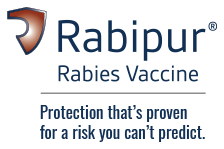RABIPUR is the leading rabies vaccine providing rapid and robust protection.
RABIPUR is indicated for active immunisation against rabies in individuals of all ages.

As a registered member of Bavarian Nordic, you can request a visit from a Bavarian Nordic representative.
RABIPUR is indicated for active immunisation against rabies in individuals of all ages.


The efficacy and safety of RABIPUR have been demonstrated extensively in more than 50 clinical trials worldwide
RABIPUR has demonstrated efficacy and tolerability in several populations:
Healthy adults and children
Individuals bitten by laboratory-proven rabid animals
Malnourished children
Immunocompromised individuals
Optimal protection is reached as early as 14 days after starting RABIPUR administration, both as pre- or post-exposure prophylaxis
A purified chick embryo cell-culture vaccine (PCECV) that contains inactivated rabies virus (strain Flury LEP)
Indicated for active immunisation against rabies in individuals of all ages
May be used as a pre-exposure prophylaxis vaccine (PrEP) as well as for post-exposure prophylaxis (PEP)
RABIPUR has the longest shelf-life among other commercially available rabies vaccines
Following completion of the recommended primary immunisation schedule, an immune response indicative of rabies protection is achieved in almost all individuals.
PrEP
PEP
*Very common = ≥1/10; common = ≥1/100
For more information on RABIPUR, please contact Bavarian Nordic.
Giesen A et al. Expert Rev. Vaccines 2015;14(3):351–367.
IQVIA MIDAS. Monthly data, 2018-2020, (accessed June 2020).
RABIPUR Summary of Product Characteristics (updated 06 February 2020). Available at: https://www.medicines.org.uk/emc/product/2502/smpc, (accessed April 2020).
Dreesen et al. Vaccine 1989;7:397–400.
Lumbiganon et al. Asian Pac J Allergy Immunol 1989;7:99–101.
Briggs et al. Vaccine 2000;19:1055–60.
Briggs et al. Bull World Health Organ 2000; 78: 693–8.
Liu et al. Hum Vaccin 2011; 7: 220–4.
Rupprecht CE et al. In:. Plotkin, Walter A. Orenstein, Paul A. Offit, Kathryn M. Edwards, Plotkin's Vaccines (Seventh Edition), Elsevier, 2018, pp. 918-942.
Vodopija et al. Vaccine 1986; 4: 245.
Kamoltham et al. Adv Prev Med 2011; 2011: 403201.
Pengsaa et al. Pediatr Infect Dis J 2009; 28: 335–7.
Sampath et al. Vaccine 2005; 23: 1102–5.
Sehgal et al. Indian Pediatr 1994; 31: 133–7.
Shanbag et al. Hum Vaccin 2008; 4: 365–9.
Briggs et al. 2011. Available at: http://whqlibdoc.who.int/publications/2011/9789241501088_eng.pdf, (accessed April 2020).